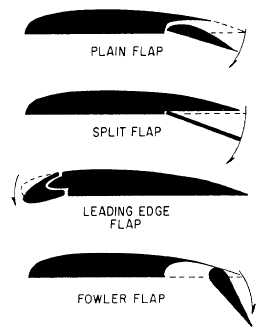data computer to generate wing sweep commands
consistent with the aircraft’s speed, altitude, and
configuration of the flaps and slats. If the automatic
mode is used to apply the commands, the wings are
positioned at a rate of 7.5 degrees per second.
Mechanical Control.—When wing sweep is in the
mechanical control mode, the wing sweep handle uses
the wing sweep/flap and slat control box to position the
wings. Because minimum wing sweep limiting is not
available in the mechanical control mode, the wings can
be swept to an adverse position that could cause damage
to the wings. Mechanical control is used for emergency
wing sweep and wing oversweep.
Secondary Flight Controls
Secondary flight controls include those controls not
designated as primary controls. The secondary controls
supplement the primary controls by aiding the pilot in
controlling the aircraft. Various types are used on naval
aircraft, but only the most common are discussed here.
TRIM TABS.—Trim tabs are small airfoils recessed
in the trailing edge of a primary control surface. Their
purpose is to enable the pilot to neutralize any
unbalanced condition that might exist during flight,
without exerting any pressure on the control stick or
rudder pedals. Each trim tab is hinged to its parent
control surface, but is operated independently by a
separate control.
The pilot moves the trim tab by using cockpit
controls. The tab on the control surface moves in a
direction opposite that of the desired control surface
movement. The airflow striking the trim tab causes the
larger surface to move to a position that will correct the
unbalanced condition of the aircraft. For example, to
trim a nose-heavy condition, the pilot sets the elevator
trim tab in the “down” position. This causes the elevator
to be moved and held in the “up” position, which, in turn,
causes the tail of the aircraft to be lowered. Without the
use of the trim tab, the pilot would have to hold the
elevator in the up position by exerting constant pressure
on the control stick or wheel.
Construction of trim tabs is similar to that of the
other control surfaces, although greater use is being
made of plastic materials to fill the tab completely.
Filling the tab improves stiffness. Tabs may also be
honeycomb filled. Tabs are covered with either metal or
reinforced plastic. Trim tabs are actuated either
electrically or manually.
WING FLAPS.—Wing flaps are used to give the
aircraft extra lift. Their purpose is to reduce the landing
speed, thereby shortening the length of the landing
Figure 1 -9.—Types of flaps.
rollout. They are also used to assist in landing in small
or obstructed areas by permitting the gliding angle to be
increased without greatly increasing the approach
speed. In addition, the use of flaps during takeoff serves
to reduce the length of the takeoff run.
Most flaps are hinged to the lower trailing edges of
the wings inboard of the ailerons; however, leading edge
flaps are in use on some Navy aircraft. Four types of
flaps are shown in figure 1-9. The PLAIN flap forms
the trailing edge of the airfoil when the flap is in the up
position. In the SPLIT flap, the trailing edge of the
airfoil is split, and the bottom half is so hinged that it can
be lowered to form the flap. The FOWLER flap
operates on rollers and tracks. This causes the lower
surface of the wing to roll out and then extend
downward. The LEADING EDGE flap operates
similarly to the plain flap. It is hinged on the bottom side
and, when actuated, the leading edge of the wing
actually extends in a downward direction to increase the
camber of the wing. Leading edge flaps are used in
conjunction with other types of flaps.
SPOILERS.—Spoilers are used for decreasing wing
lift; however, their specific design, function, and use
vary with different aircraft.
The spoilers on some aircraft are long, narrow
surfaces hinged at their leading edge to the upper wing
skin. In the retracted position, the spoiler is flush with
the wing skin, In the extended position, the spoiler is
pivoted up and forward approximately 60 degrees above
the hinge point. The spoilers disturb the smooth flow of
air over the wing so that burbling takes place. The lift is
1-10



